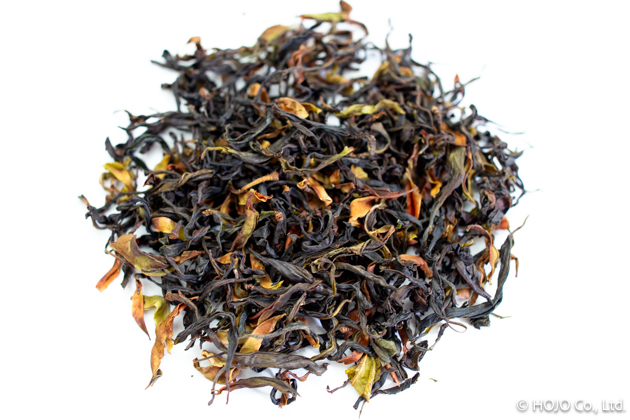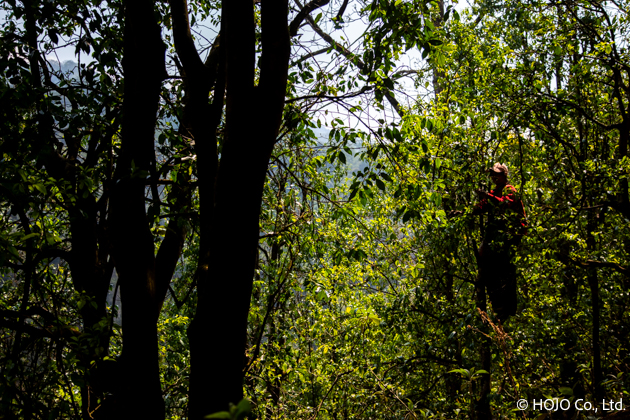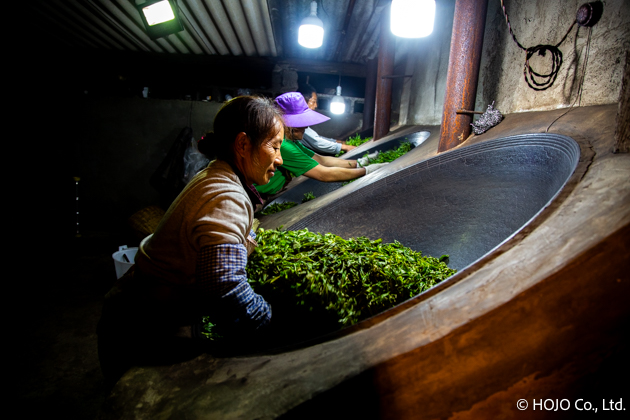- HOME >
- New Arrival at HOJO Online Shop
New Release of Da Xue Shan Wild Tea 2024 Loose Leaf
- [2024.09.18] Posted By Akira Hojo

Da Xue Shan Wild Tea is a raw pu-erh tea made from Camellia taliensis, which grows wild on Da Xue Shan in Yongde County, Lincang City, Yunnan Province.
What is Wild Tea?
Wild tea refers to naturally growing tea found in the mountains, not to aged tea trees or cultivated tea that has reverted to the wild.
As I’ve explained before, in Yunnan Province, whether Camellia taliensis grows wild or is cultivated, it is traditionally called wild tea. Ideally, wild tea should refer to tea that grows naturally in the mountains, but in Yunnan, people call Camellia taliensis wild tea even when it’s cultivated in fields. This is because Camellia taliensis originally grew wild in the mountains, much like how people refer to cultivated wild strawberries as “wild” even though they are grown in gardens. In both cases, the term “wild” is used because of the plant’s natural origin, despite its being cultivated in a controlled environment. The name persists because it helps identify the type of plant, even if it doesn’t reflect its current growing conditions. In fact, most wild tea on the market is not harvested from the mountains, just as many so-called wild strawberries come from cultivated plants.

We place great importance on sourcing genuine wild tea from the mountains. We travel to the region to ensure we obtain truly wild tea, not cultivated plants, in pursuit of the rich aftertaste and long-lasting flavors that only real wild tea can offer.
Monitoring Pan Frying On-site
With the end of the COVID-19 pandemic, travel to China has become possible again, and I entered Yunnan Province in late March to oversee the production of wild tea. I visited Yunnan at this time specifically to participate in the production of wild tea. In Yunnan Province, many producers tend to pan-fry wild tea at high temperatures, which can cause the delicate aromatic compounds to oxidize and volatilize due to the heat.

The early stages of pan frying in pu-erh tea production are more like cooking rice than stir-frying vegetables. The pan is thoroughly heated, and once it reaches the right temperature, tea leaves are added quickly to allow heat to penetrate and release steam. After steam starts to appear, the temperature is lowered, and the tea is gradually pan-fried.
However, in Yunnan, many producers tend to overheat the pan at the beginning and fail to reduce the temperature once the steam appears. If the temperature isn’t lowered after the moisture evaporates, the tea can easily scorch. Since tea frying often continues until dawn, workers in a rush to finish may push the process by using excessively high temperatures in a short time.
This year, I was involved throughout the production season, implementing various management practices to achieve an ideal quality. The tea has a bright flavor, reminiscent of grapes, apples, and young tree bark. While there are areas to improve for next year, I’m generally satisfied with the result of this year’s tea.
The tea will be sold in both loose-leaf and cake forms. The loose-leaf tea will be available in limited quantities, so please consider purchasing early.



How to Buy This Tea
For international customers, please send us an email at info2@hojotea.com.
For customers in Malaysia, Singapore, and Brunei, please click here to visit the product page or make your purchase directly from the shopping cart below.
Related Articles
How to get the latest update on HOJO?
1. Follow Twitter, 2. Click "Like" on Facebook, and 3. Subscribe in newsletter. You can have the latest tea news from HOJO.
 Subscribe the Newsletter to enjoy the privileges
Subscribe the Newsletter to enjoy the privileges- You may receive a free sample upon purchase, or you may have the priority to purchase special products. So please remember to subscribe our newsletter as well as the social network.
- Myanmar White Tea Bud 2013 from Guo Gan, Myanmar
- We have released a raw Pu-erh tea, 緬甸白芽茶 2013 (Myanmar White Tea Bud 2013), produced by ethnic minorities in t …
- Yong De Wild White Tea 2025 Loose Leaf Limited Release
- We have released Yong De Wild White Tea Loose 2025. For the 2025 harvest, only the loose-leaf type was …
NEW ARTICLES
 Myanmar White Tea Bud 2013 from Guo Gan, Myanmar
Myanmar White Tea Bud 2013 from Guo Gan, Myanmar- We have released a raw Pu-erh tea, 緬甸白芽茶 2013 (Myanmar White Tea Bud 2013), produced by ethnic minorities in t …
 Yong De Wild White Tea 2025 Loose Leaf Limited Release
Yong De Wild White Tea 2025 Loose Leaf Limited Release- We have released Yong De Wild White Tea Loose 2025. For the 2025 harvest, only the loose-leaf type was …
 Experience the True Freshness of Raw Pu-erh : Tang Jia 2025 Loose Leaf Release
Experience the True Freshness of Raw Pu-erh : Tang Jia 2025 Loose Leaf Release- We have released Tang Jia Raw Pu-erh Tea 唐家古樹生茶 2025 Loose Leaf. Among HOJO’s raw pu-erh teas, Tang Jia Raw Pu …
 Yunnan Chun Jian Green Tea from High Mountain Gardens
Yunnan Chun Jian Green Tea from High Mountain Gardens- Yunnan Chun Jian Green Tea is now available. This tea is made from naturally grown leaves harvested from high …
 Limited Loose Leaf Release of 2025 Da Xue Shan Wild Raw Pu-erh Tea
Limited Loose Leaf Release of 2025 Da Xue Shan Wild Raw Pu-erh Tea- We have released the 2025 loose-leaf version of Da Xue Shan Wild Raw Pu-erh Tea. This tea comes from wild tea …
 Discover a New Way to Enjoy Tea: Cooking Rice with Tea
Discover a New Way to Enjoy Tea: Cooking Rice with Tea- Cooking rice with tea is a simple idea, but it brings surprisingly satisfying results. The tea’s flavour seeps …
 2025 Da Xue Shan Wild White Tea Now Available from Yunnan
2025 Da Xue Shan Wild White Tea Now Available from Yunnan- The 2025 harvest of Da Xue Shan Wild White Tea is now available. Crafted from truly wild Camellia taliensis tr …
 Fresh 2025 Yunnan White Tea – Select Your Favourite Lot Before Blending
Fresh 2025 Yunnan White Tea – Select Your Favourite Lot Before Blending- Freshly crafted in Yunnan and just arrived in KL, our new 2025 white tea is now available at our Gardens Mall …
 2024 Dong Shan Raw Pu-erh Tea – Crafted with the Producer for Desired Quality
2024 Dong Shan Raw Pu-erh Tea – Crafted with the Producer for Desired Quality- We have released the 2024 cake of Dong Shan Raw Pu-erh Tea. Earlier, we offered the loose-leaf version from th …
 Development of Firewood Roasted Hojicha Using Naturally Grown Tea from Yunnan
Development of Firewood Roasted Hojicha Using Naturally Grown Tea from Yunnan- We are currently staying in Yunnan Province for tea production. As the season nears its end, tea trees with pa …
Category
- New Arrival at HOJO Online Shop
- Featured Articles
- Newsletter
- Types of Tea
- Origin of Tea
- Teapot and Tea Equipment
- Tea Column
- How to enjoy tea
- Tea Processing
- How to choose quality tea
- Tea constituents and functional effect
- Safety of Tea
- Foods
- Tea Business Operation
- Hobby and Outdoor Activity
- Ranking of Tea
- Video
- FAQ
- Media Release
Profile

- AKIRA HOJO
- I invite you to experience my tea selections.I was born in Nagano, Japan. In university, I studied agricultural chemistry, and I have the master degree in food science. I worked in Japanese food industry for 10 years. I involved in R&D, QC and QA. As a factory manager, I implemented ISO9000 series and managed the factory.
- The Art of Tea Magazine
- We posted the article on “The Art of Tea Magazine No.9, the magazine is published in Taiwan. We featured …
- New Straits Times
- The Malaysian National Newspaper, New Straits Times featured HOJO Tea on 17-Oct-2007.
Shop Info

Address:Lot No. T-215, 3rd Floor, The Gardens Mall, Mid Valley City, Lingkaran Syed Putra, 59200 Kuala Lumpur
Tel: +603-2287-4537
Business Hour: 10am to 10pm














